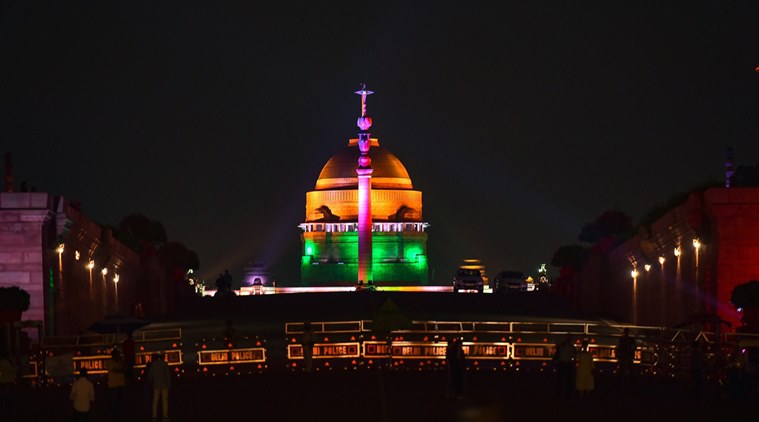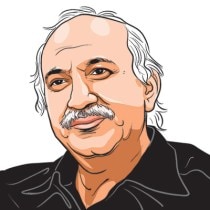A brief history of democracy
A stable government helps India show the world that freedom and prosperity can travel together

For over five decades, India could not grow at the true potential of Indians. (Source: PTI Photo)
On 15 August 1947, at the stroke of the midnight hour, while half the world slept and the other half lay chained by colonialism, the epochal question before the Indian people switched. Till then, it was: “When shall we get freedom?” After 15 August it became: “What shall we do with freedom?”
Mahatma Gandhi had answered the first question. When he launched his phase of our freedom struggle in 1919, a notable Indian sceptic famously scoffed: “What does this man in a dhoti think he is doing? The British empire will last 400 years.” Once Gandhi lit the long-dormant spark within Indians, the British were out in less than 30 years. India’s liberation signalled the end of Europe’s colonial project. Within another 30 years, colonial rule had vanished. But the question it left in its wake — “What shall we do with freedom?” — is still searching for answers across the world.
The first part of the answer was easy. India had not won freedom from Britain in order to deny freedom to its own people. Democracy, equality and their attendant rights became the first and fundamental principles of India’s Constitution.
It is often suggested, by apologists of Empire, that the British gave us democracy. Gandhi did not need anyone’s advice on the meaning of freedom. He believed in the people and their rights. His programme was anchored in mass action. He rejected both the class elitism of Lords and Ladies and the class conflicts of Karl Marx. The British did not give us democracy. What they gave us was the Westminster model, which is quite another story.
There is no perfect polity. As political architecture, the Westminster model has much to commend it. Its racehorse simplicity (“first past the post”) finesses the fractures in proportional representation. Such fractures can easily become fissures under the pressure of power politics, with dangerous unintended consequences. But while Westminster offers confidence at the electoral base, it begins to wobble at its upper stories. The absence of fixed terms for Parliament, for instance, makes any government vulnerable to destabilisation. A president of America, in contrast, can only be removed from office through a fixed-date election (barring impeachment). The people elect, the people reject. Other democracies have taken steps to protect the democratic edifice from structural flaws. France ended serial instability with President Charles de Gaulle’s reforms. Italy could not, and the consequences are the substance of daily news.
Political stability in India has always required a prime minister who can command both the confidence of Parliament and the trust of the people. We witnessed this level of stability only for a decade after the first general election in 1952. Prime Minister Jawaharlal Nehru retained the confidence of Parliament after the war with China in 1962, but trust in his government was shattered by traumatic defeat. Nehru had to resort to anxious measures like the Kamaraj Plan in October 1963 to allay the seismic tremors. But it was too late and never enough. Nehru and his friend, Egypt’s Gamal Nasser, suffered the same fate. Nasser’s popularity survived defeat in the 1976 war with Israel, but not his credibility.
In the 1967 elections, Congress, now led by Indira Gandhi, lost all state governments from Punjab to Bengal, and survived in Delhi by a narrow margin. What was implicit became explicit. In 1969, her government lapsed into a minority when the Congress split. Mrs Gandhi veered steeply towards the left in her economic policies, in order to woo Communist support to survive.
Instability turned the 1960s into a decade of hunger, violence and skewered policy. Near famine conditions forced Mrs Gandhi to swallow her pro-left rhetoric and turn to America for wheat to stave off nationwide hunger, paying America in rupees that Washington did not know how to spend. Naxalite and communal violence spread across the country. The young felt helpless and hopeless. Worse, the non-Congress parties that took office in the states, proved, mostly, to be as jittery as the Congress. There was “collaborative instability”.
The 1970s paid the economic price for the pseudo-leftism of the 1960s. Mrs Gandhi blamed democracy instead of herself and imposed a draconian Emergency, snatching their precious freedom away from Indians. There was economic chaos, spiked by growing corruption. The only bright spot was the courage and capacity of our armed forces, which protected India’s integrity in the 1965 war and decisively helped Bangladesh’s liberation war in 1971. But all the glory of victory in 1971 could neither hide nor postpone a crisis that was turning endemic.
The Janata government, elected in 1977, could have been the stable antidote, and pioneered the economic reforms that would have transformed India. Instead, Janata degenerated into a cure that was worse than the disease. Its tantrums angered the voter; however, Mrs Gandhi’s return in 1980 brought stability to Parliament but not to the country. A nadir was reached by compromise with radical groups. The gathering internal chaos gave foes the chance to arm, finance and protect secessionists, with the epicentre shifting to Punjab. The traumatic cost of of the 1980s has still not been accurately calculated, and continues to echo.
By 1991, we were bankrupt. There is no other word for it. Our gold reserves were taken away by European bankers as collateral for foreign exchange that we needed to prevent catastrophic default. There was no option but reform, even if the widows of faux socialism kept up their bleat.
But these economic reforms under the leadership of Prime Minister Narasimha Rao began to falter because his government lacked a majority, and compromise became essential for survival. The polity seemed to splatter after the 1996 elections ushered in two coalitions which can only be described as non-performing liabilities. From 1999 Prime Minister Atal Bihari Vajpayee led a comparatively stable government but had to juggle between compelling pressures from 22 partners.
The UPA experiment between 2004 and 2014 was a demonstration of the thesis that everything that can go wrong will go wrong. Its most damaging legacy was corruption, in particular, the rampant collusion between the most powerful ministers and business interests through middlemen. In a few cases, middlemen were unnecessary because the loot was made and kept within the family. Public, and private, memory is proverbially short, but it would be dangerously complacent to forget what we heard on the Radia tapes.
For over five decades, India could not grow at the true potential of Indians. India’s economy became a victim of its politics. Chronic instability can turn government into a bazaar, trading at deep discount, filling fat cat pockets, and hiding failure with vote-bank rhetoric. The poor, inevitably, were the worst victims of this failure. Till five years ago, a high official of the UPA, the executive head of the Planning Commission, was telling the impoverished that Rs 32 a day was enough for them.
2014 witnessed the arrival of democratic stability and a leader in Narendra Modi, who said, in his first speech in Parliament, that poverty alleviation was not enough; his mission was poverty elimination and to speak of development for all. He addressed harsh poverty through radical instruments like technology, and focussed policies like gender emancipation, quality of life infrastructure (toilets, electricity, gas cylinders), and a birth-to-death security cover. Today, an assessment by Brookings foresees only 3 per cent of India living below the poverty line by 2022. With effort, this will become zero. This answers the second question of 1947. What does freedom mean if there is no freedom from poverty?
There is only one possible obstacle — instability. Democracy offers a choice between options, not absolutes. 2019 is another year of choice in another general election. With five more years of a stable government and a committed leader, India will have shown the world that freedom and prosperity can travel together.
The writer is Union Minister of State for External Affairs
For all the latest Opinion News, download Indian Express App
More From M J Akbar
- From 1975 to 44Emergency did not end dynasty in Indian politics. But it kicked off its journey into irrelevance..
- Narrative of the forked tongueFrom Shah Bano to triple talaq, lies and deception are being used to cheat women of rights. It won’t work...
- For the Record: For an Islamic modernityFreedom, knowledge and gender equality have to be its pillars...







































No hay comentarios:
Publicar un comentario